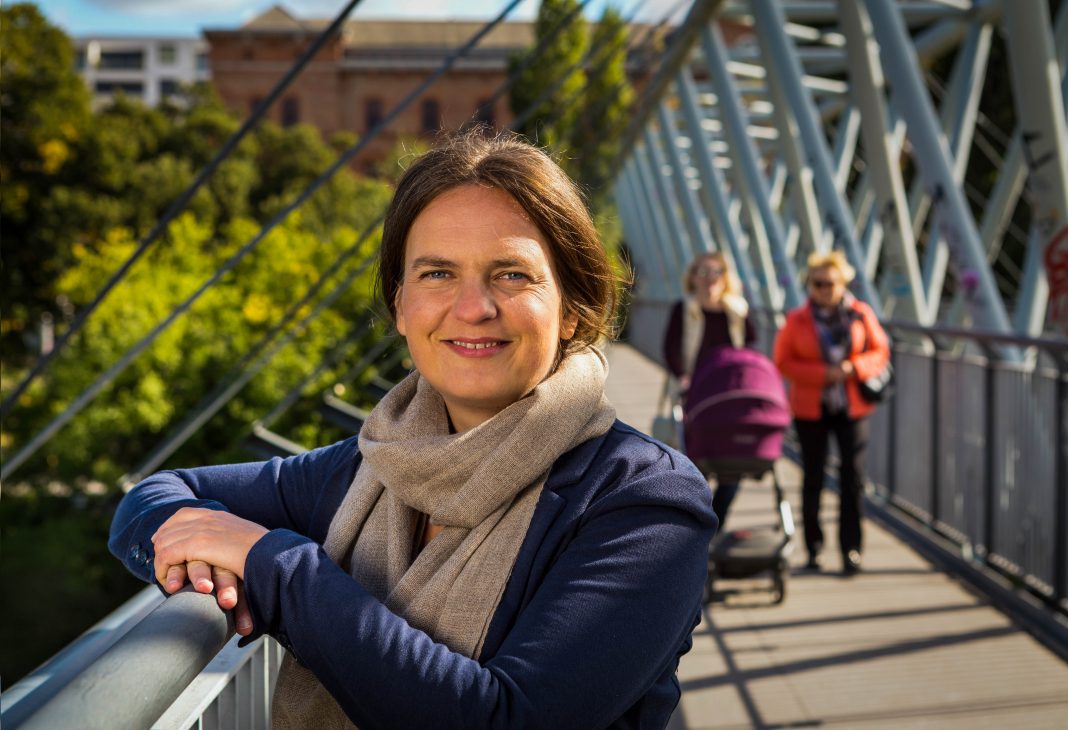Petra Jens has been Vienna’s walking commissioner since 2013, aiming to make the city a pedestrian paradise. But what is it exactly that a walking commissioner does, and does every city need one? We sat down with Petra to talk about her tasks, the power of communication, empowerment of citizens, and her visions for Vienna.
It’s true that more and more cities are starting to appoint pedestrian coordinators. Still, Petra’s role is unique: she doesn’t know of any other pedestrian coordinator worldwide that is neither performing regulatory tasks (such as official inspections) nor jointly responsible for cyclists. In her role, she fulfils purely communicative tasks. But what does that imply? And why is it important?
Resilience and Justice: Functions of Public Space
When asked about why walkability matters, both to a city and to her personally, Petra knows that there are a lot of lenses to look through. Think about it: the best way is the one you don’t actually have to make.
If you offer people a living environment connected by short distances and where they can walk a lot, many traffic-related difficulties are solved automatically. Additionally, walking has a social aspect: people meet each other in public space, talk to each other, establish relationships, have arguments. This makes a city more resilient.
But there is more: the fact that walking also has a lot to do with justice is an influence that has accompanied Petra personally for much longer than the Mobility Agency Vienna (Mobilitätsagentur Wien), in which she is now working, has even existed.
At a time when she had three small children and was very much on the move in her neighbourhood – on foot and with a pram – Petra began to observe and analyse patterns: people in society who have very high needs for public space (i.e. children, older people, people with care responsibilities) are the ones who walk the most. In the street, these people are given very little space and time.
“I came to the conclusion that the space available for walking is treated with little respect. I also noticed that this narrow traffic area fulfils many more functions than just transit. Everything takes place there, from hanging out and communication, to commerce and gastronomy. It is the location for all kinds of infrastructure, which often also benefits car traffic. There are constant obstacles that actually do nothing for pedestrian traffic: electricity blocks, lamp posts, traffic light poles, endless amounts of traffic signs, rubbish bins… and I found that somewhat remarkable”, she states.
But why is it so difficult to make a case for walkability and redistributing space in favour of pedestrians?
The Difficulties of the Pedestrian Lobby
Many politicians are afraid of the repercussions of taking something away from people. When it comes to redistributing public space, they don’t emphasise enough that everyone benefits.
“You can’t really say that you’ll take something away from someone and give it to another specific group because pedestrians are 100 per cent of the population. That’s the interesting thing about it,” Petra asserts.
Still, the lobby for pedestrians is weak and does not have a long tradition – quite the opposite to the lobby for car drivers (and increasingly for cyclists). Why is that? Pedestrians are not a small group, after all. But paradoxically, there’s the rub: “It sounds counterintuitive now, but it is initially easier for small groups to organise themselves and to make themselves visible if they are creative enough and have enough energy.”
“Everyone together does not constitute a group. After all, we don’t define ourselves as pedestrians, just as we don’t define ourselves as lung breathers because it’s part of being human.“
Then there’s the missing object. Motorists have the car, and there is an industry, advertising, and technical issues all around it. It’s similar with cycling, but not with walking:
“We can’t hold a thing up to the camera as a symbol and say, ‘that makes me a pedestrian now’. We are connected by our humanity, but that also makes it difficult to find an angle on which to communicate.”
So, what is it that a pedestrian coordinator can do about that?
At the Core of a Walking Commissioner’s Job
As stated above, unlike many pedestrian coordinators in other cities, Petra is not responsible for the agendas of cyclists, nor does she perform the regulatory tasks of official inspections.
She sees it as a “privilege and luxury” to be able to deal with the issue of walking in the long term, to observe things, to crystallise what is essential and what will take us forward – even if she cannot spontaneously solve citizens’ problems.
“A walking commissioner is not a miracle worker. But she or he is something like a spotlight that can illuminate a very specific issue, can depict it, can collect data, can make it detectable,” Petra sums up.
“Sure, you can also do a pedestrian campaign without a pedestrian officer. You can also plan and build without a pedestrian officer. But one must not forget that the transformation of the transport system, which must go hand in hand with a transformation of the street space, is a major political achievement”, she continues, “and politics cannot do without communication. Politicians are usually caught up in day-to-day business, they don’t have the head for dealing with such things in the long term.”
If you take climate protection seriously in cities, you can’t avoid the topic of mobility because cities are usually already quite energy efficient. “In Vienna, a large part of the CO2 emissions come from the transport sector. Within the transport sector, there is no mode of transport that is as cost-effective and achieves as many positive effects as walking. That’s why it’s worth investing here, not only in the construction sense but also in the ideal sense. And that is the power of communication.”
Petra also provides empowerment to citizens, for example through weekly open-door hours: “Of course, the people who come to the consultation hours are people who have already given a lot of thought to the matter or have a more complex project. That’s where we can offer very good orientation. I often feel that this is a kind of empowerment. We’re empowering citizens to pursue their interests”, she says.
In many ways, communication is referred to as the be-all and end-all in urban change processes. How can we best communicate about pedestrians or walking, respectively?
How To: Communicating Walking
Petra’s core tasks are anchored in communication agendas. So, what is her approach to communicating walking? How can we make walking visible, actually and linguistically? How can we make it attractive? How can we work with testimonials? Here are two basic tips for cities that want to start or advance with their communication efforts:
1) Build Communication on Walking
“It’s not like you’re making a difference per se, but I think it’s a very important accompanying measure to create understanding and agreement for structural measures,” she says. An identification figure such as a pedestrian coordinator helps with that.
When you’re starting out, don’t focus on what doesn’t work and what’s challenging – focus on what’s already there, what’s good about it, and what works.
2) Avoid Deficit-Oriented Communication
It is important to work in a resource-oriented way without neglecting the difficult issues. Especially when it comes to pedestrian traffic, it’s easy to fall into a deficit-oriented style – this is often not conducive to the cause: “It is already a lot to present what you have. Of course, you have to eliminate deficits, but that doesn’t create enthusiasm.”
If the city focuses on what is already there – such as public passages or beautiful routes – and highlights that, that’s a great start:
“We have to establish positive communication, we have to show that walking is something great, that it is part of the good life, that it is worthwhile.”
“And for that, we need positive images and a positive mindset. This is natural for other modes of transport. We are surrounded by car advertising all day. Wiener Linien [Vienna’s public transport operator] advertise. It’s quite normal. It’s just for walking that it’s still a bit unusual. And that’s what we’ve started to do in Vienna.”
Personal Visions for Pedestrian Traffic in Vienna
When asked about her personal vision for walkability in Vienna for the next five years, three things come to Petra’s mind: a mobility education programme, a transparent funding structure for pedestrian traffic infrastructure in Vienna, and an overarching federal funding structure.
“I would like to establish a mobility education programme in Vienna, area-wide, sustainable, for three- to eighteen-year-olds, engaging at least 50 per cent of them. That means that about every two or three years, a Viennese child is confronted with these topics in an age-appropriate form and gets the desire to walk and cycle. That is very, very important to me. That’s where I want to get to,” she explains.
Her second wish would be a transparent funding structure for pedestrian infrastructure in Vienna, which informs districts about where they can get funding. A systematic approach to the promotion of pedestrian traffic has not succeeded in the last ten years, but hope for major impulses from the federal government remains.
This leads to her third vision: to establish a federal funding structure for pedestrian infrastructure. In Austria, walking is the responsibility of the municipalities, which in Vienna would be the districts, the smallest municipal unit. Naturally, they don’t have the largest budgets but are responsible for maintaining their municipal roads. As of now, there are few incentives to change them in a way that would be better for walking. Change is on the way, though: very recently, information was released that the first nationwide funding for infrastructure that favours walking is installed.
These are the three most important topics that will occupy and move Petra in the next five years. Admittedly, there is still a lot to do in all three areas, but the seed is sown!
Curious to learn more about Vienna? Read about what makes the city great for pedestrians here!


